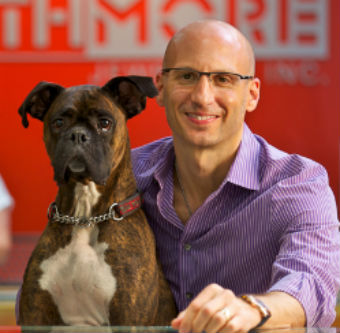Articles and News
Top Independent Jewelers On Survival: Learn Technology, Not Gemology! | June 14, 2017 (1 comment)

Las Vegas, NV—Amid endless discussions about how retail is changing and what jewelers need to do to remain relevant, three highly successful jewelers are already doing it. In a special session during the JCK Show titled “Small Town, Big Business,” they gathered to share their strategies for reinventing themselves.
Michael Pollak (left), owner of of Denver, CO-based Hyde Park Jewelers with seven luxury stores and additional branded boutiques, joined Harris Botnick, founder of Worthmore Jewelers in Atlanta, GA, and John Saslow of Saslow’s and Henebry’s Jewelers, a 13-store independent chain with stores in North Carolina, Tennessee, and Virginia, for a discussion with Amy Marino, vice president of marketing, experience and partnerships for American Express’s Small Business Saturday program. Rob Bates, JCK’s news director, served as moderator.
“Why is so much jewelry sold via independents? What lends itself to brick and mortar, and what can independents do to reinvent themselves?” asked Bates.
“We're the only industry, along with automobiles, that services what we sell. And we’re the only industry that sells something that lasts, can be handed down, and can be remade,” said Botnick. Service and repairs bring people into jewelry stores so jewelers have to raise the bar to get them to look at more merchandise. “Go into an Apple store and they show you things, but we were doing that years ago!”
Marino said the integration of independent jewelers into their community is critical. “I think a lot of the authenticity of what jewelry is about is trust, and when you see jewelers are part of the community you’re more likely to trust them and pay a premium price for something you're going to buy than you would with a low-touch experience.”
Research conducted through American Express’s Small Business Insight Study has shown that personalized one-of-a-kind experiences consumers can’t get anywhere else are important, and 80% are willing to pay more for quality. “Big box retailers can offer lower prices but small business is able to buck that trend when they are offering a personalized high-touch experience. It goes hand in hand with the opportunity to charge just a little more.”
“Think back before the Internet and before diamond price lists. The local neighborhood jeweler was a trusted store,” said Saslow. “This is a throwback to that. A confidant and trusted advisor can't be substituted by the Internet.”
So if jewelers are doing everything right, why is the industry struggling so much?
Botnick acknowledged the shrinking of the industry, wholesale and retail, but pointed to e-commerce sites now adding concierge services—i.e. human interaction. “The need for touch and contact is not going away.”
Pollak says family business heritage, while important for all the reasons Marino stated, is no longer enough. “We’re in a period of disruption like no other. The disruption is only going to accelerate, so jewelers have to do more than they've ever done before to create business. You used to open your doors and people came in, but no more. No matter where you are, if you’re not using technology and data to focus on your core customers, you will not succeed.
“Also, the notion that if you build a website they will come is not true either. You have to connect with consumers the way they want to connect with you—not how you choose to connect with them.”
Being online doesn’t necessarily mean selling online, said Marino. Social media is extremely important to drive customers through brick-and-mortar doors. “There’s a lot you can do on social media to play up the heritage and uniqueness of your store. Maybe you're the only person who sells a brand, a type, a stone, et cetera. Additionally, in social media, the visual is everything. If there's one thing I would suggest to any small business owner, it’s to learn to take a great iPhone photo. For my generation, for Millennials, this is where we're looking for inspiration! I follow a ton of small businesses in my area, and if I see something cool I'm going to get up and go check it out!”
“I think you should emphasize that the days when you open your doors and they come are over! An online presence is mandatory. Whether social, digital, or behavioral, a data-driven approach is critical,” added Saslow. While only one out of 50 jewelers he spoke to seems to be successful [selling] online, it’s still critical to to bring customers in.


Left to right: Harris Botnick and friend; John Saslow.
So what’s the barrier? If technology is essential to jewelers’ survival, why are so many lagging at it?
Botnick and Pollak blame tradition. “We’re in an old-history business and people are scared,” said Botnick, a first-generation jeweler. “So many people were trained by their parents and are not keeping up with technology. When we got in the industry, we did so many things that people said, ‘you can't do that, that's not how it’s done.’ We said ‘we're doing it,’ and it's been successful. I have Millennials in the store and I allow them to take the reins and let them show me what they know.”
Pollack said digital education needs to come before gemological education. “My peers were mostly second- and third-generation jewelers, and it seemed like the career path was, ‘go to GIA, then go work for another jeweler, and then you’re ready for the jewelry business.’ The model didn’t change much for the first 75 years.
“We adapted [digitally] very early on because we didn't have anyone tell us the rules. We made a lot of mistakes, but we did a lot more things right than wrong. Today I’d take a very different approach. If I had kids in the business, I would make sure they have a digital-first attitude. Industry knowledge is important, but is digital is more important. Make sure you hone your skills in digital, and get a gemological background second.”


iPad before microscope: becoming digitally savvy needs to take precedence over gemological skills for jewelers now, says Michael Pollak.
Marino said social media is a very low-risk platform and the only way to get better is by testing and seeing what works. Put up a post and if you don’t get engagement, figure out why not. “If you show it to a Millennial working in the store, I bet you’ll get a good answer! Ask customers how they found out about you, especially younger ones. A lot may say it’s because of something they saw in social. Word of mouth is really strong, particularly in communities and neighborhoods.”
“Online reviews are the biggest manifestation of word-of-mouth,” said Pollak. They’re especially essential for Gen X, Millennial, and even Gen-Z shoppers. “We're curating those and encouraging people to review us. Most of the time it’s extraordinarily positive, but sometimes it’s not and then we get involved on a one-on-one basis to see if we can change their opinion or experience.”
The eternal debate about showing prices online came in for brief discussion, with Saslow firmly in the opposition camp. “If you put prices too low online it undercuts the retail store, but if you put a full retail price online, nobody will buy it. It’s ok for standard items or branded items with a set price, but for bridal you want them to come in. When brides see styles they like, they do call or email or click ‘contact us’ for more information.” (Editor’s note: a quick scan of the Saslow’s website indeed shows no prices, nor does Worthmore’s. Hyde Park’s website shows prices throughout.)
The final question Bates put to the panel—all in malls or shopping centers—was, “Are malls dead?”
“We all read the same predictions,” said Pollak. Located in high-end malls, Hyde Park Jewelers bucks the trend for luxury jewelers. But regardless of location, jewelers need to focus on their role in the community, he said. Hyde Park created a foundation to give back to the communities where it lives.
“Last year, we had a campaign, ‘40 Acts of Kindness.’ We make sure to touch, in a meaningful way, 40 organizations in markets we’re involved with.”
Botnick said, “Being in the community is more important. We did a program for brain cancer awareness called ‘Paint The Town Gray.” We did another providing winter things for police and firemen. We are always being asked by schools and such, and we say we will—but please support us so that we're here to support you.”
Don’t be afraid to ask for their support in return, he emphasized. “A friend with a restaurant always asks requesters what their favorite item on the menu is, and many say they’ve not eaten there. He asks them to eat there so that he can stay in business and help support their cause.”
“A mall at its broadest definition is a commerce center in the community,” said Marino. Whether big box center, traditional mall, or lifestyle center, it’s a location people congregate in. “There’s an increasing desire by consumers to understand the impact of their dollars, wherever they’re spending. The Small Business Insight Study shows that 70% of every dollar spent at a small business stays in the community, four times greater than what is spent at a larger chain store.
“We're the case study for the classic advantage of being in a mall: they attract customers, you open your doors and you do business,” said Saslow. “It used to work but it stopped working. Malls will not be gone, but they don't seem to be main place people want to go shopping anymore. But if you have strong value statement and all the things we talked about, it doesn't matter where you are, people will come to you.”
More on the decline of malls and growth of independent retailers here.
Read more about boosting your sales with in-store technology here.







